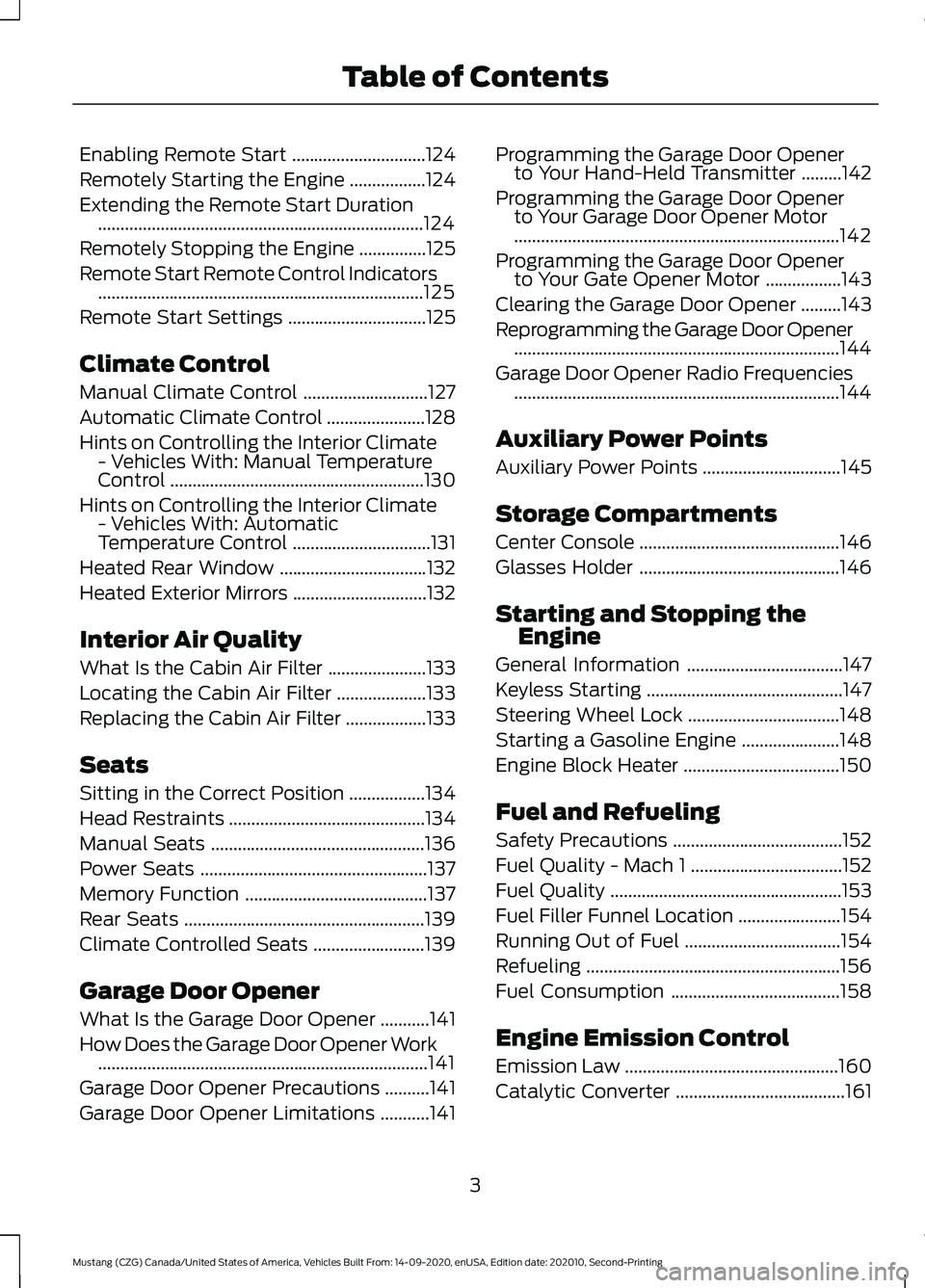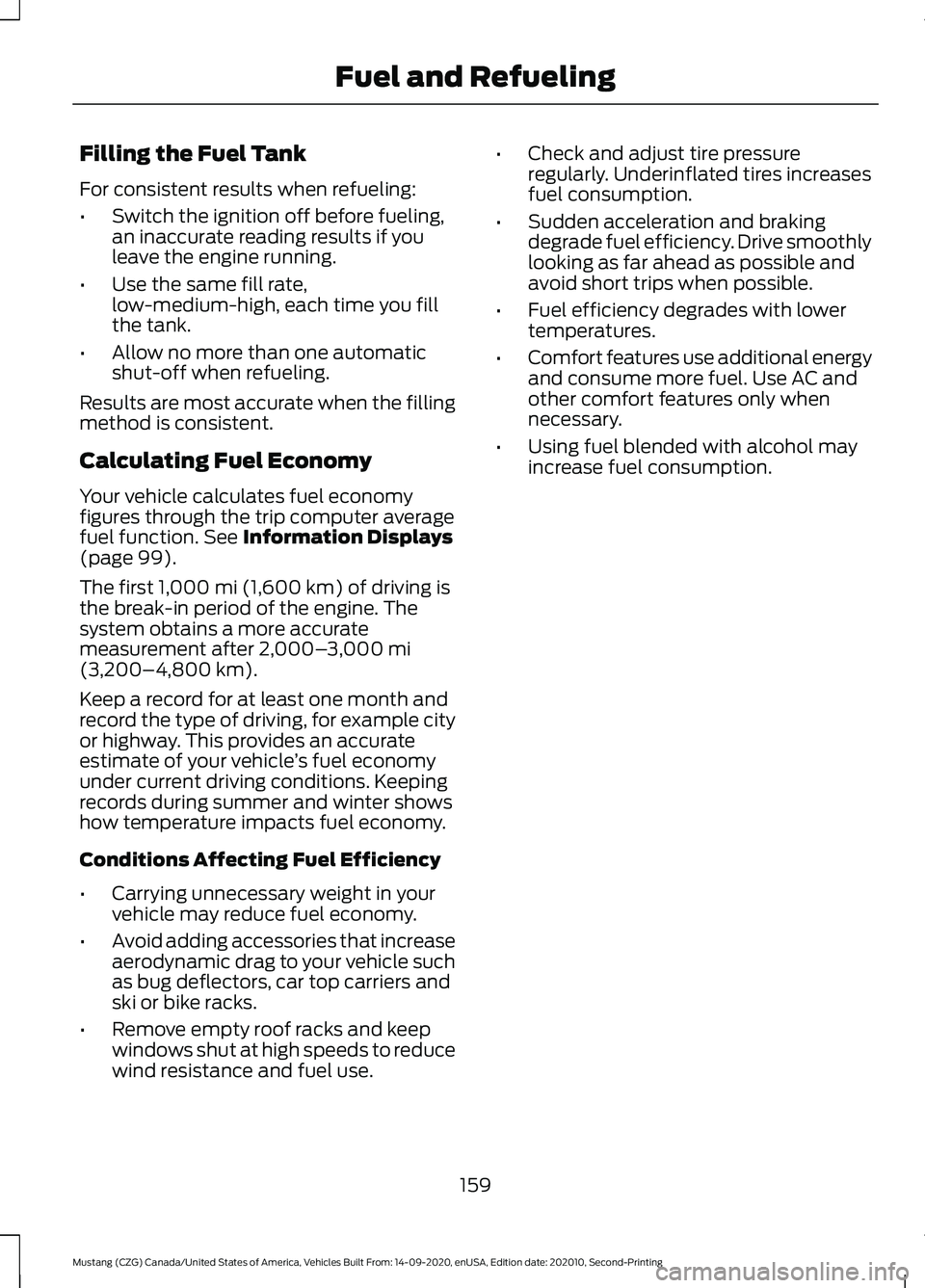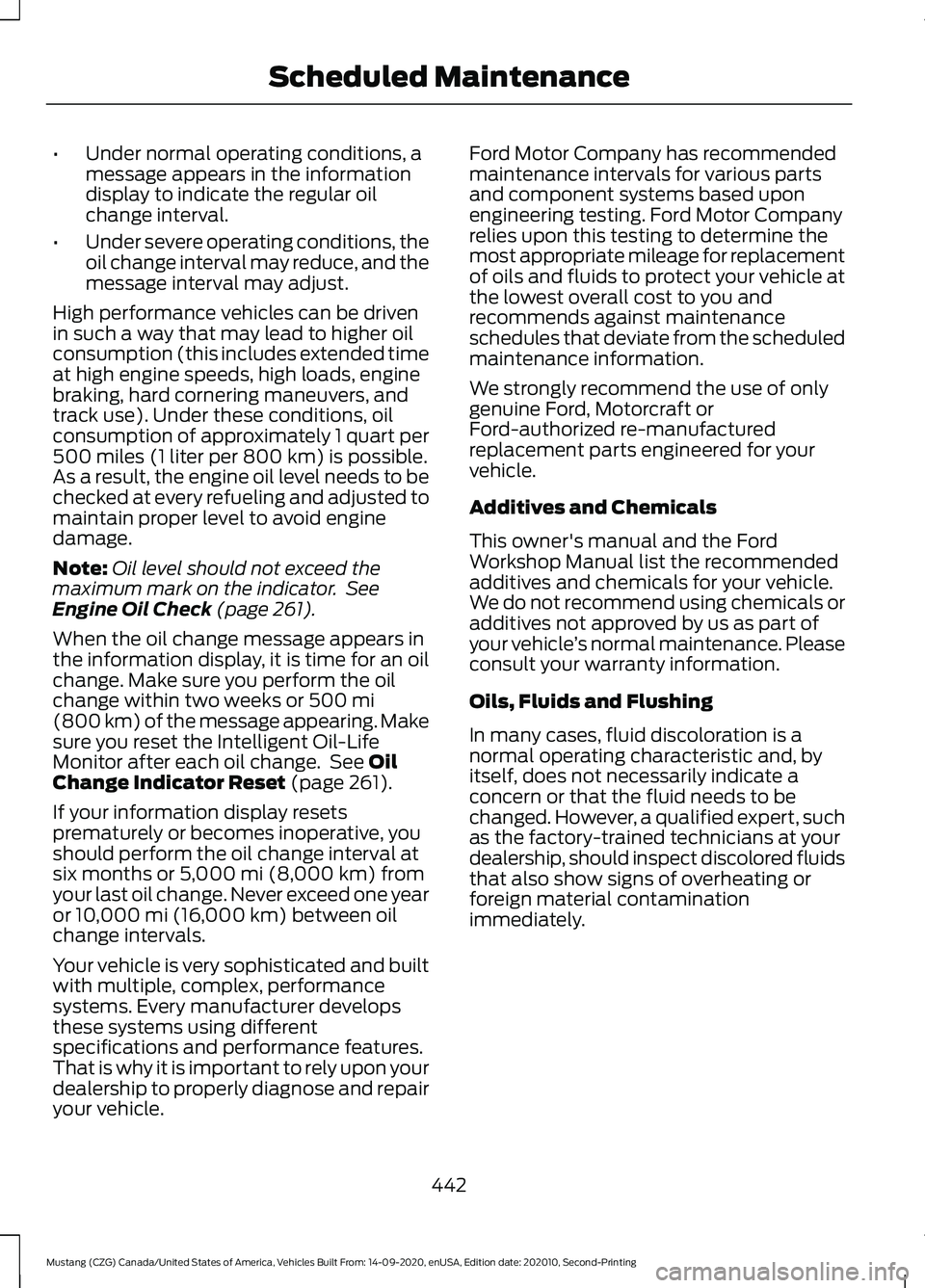2021 FORD MUSTANG fuel consumption
[x] Cancel search: fuel consumptionPage 6 of 530

Enabling Remote Start
..............................124
Remotely Starting the Engine .................
124
Extending the Remote Start Duration ........................................................................\
.
124
Remotely Stopping the Engine ...............
125
Remote Start Remote Control Indicators ........................................................................\
.
125
Remote Start Settings ...............................
125
Climate Control
Manual Climate Control ............................
127
Automatic Climate Control ......................
128
Hints on Controlling the Interior Climate - Vehicles With: Manual Temperature
Control .........................................................
130
Hints on Controlling the Interior Climate - Vehicles With: Automatic
Temperature Control ...............................
131
Heated Rear Window .................................
132
Heated Exterior Mirrors ..............................
132
Interior Air Quality
What Is the Cabin Air Filter ......................
133
Locating the Cabin Air Filter ....................
133
Replacing the Cabin Air Filter ..................
133
Seats
Sitting in the Correct Position .................
134
Head Restraints ............................................
134
Manual Seats ................................................
136
Power Seats ...................................................
137
Memory Function .........................................
137
Rear Seats ......................................................
139
Climate Controlled Seats .........................
139
Garage Door Opener
What Is the Garage Door Opener ...........
141
How Does the Garage Door Opener Work ........................................................................\
..
141
Garage Door Opener Precautions ..........
141
Garage Door Opener Limitations ...........
141Programming the Garage Door Opener
to Your Hand-Held Transmitter .........
142
Programming the Garage Door Opener to Your Garage Door Opener Motor
........................................................................\
.
142
Programming the Garage Door Opener to Your Gate Opener Motor .................
143
Clearing the Garage Door Opener .........
143
Reprogramming the Garage Door Opener ........................................................................\
.
144
Garage Door Opener Radio Frequencies ........................................................................\
.
144
Auxiliary Power Points
Auxiliary Power Points ...............................
145
Storage Compartments
Center Console .............................................
146
Glasses Holder .............................................
146
Starting and Stopping the Engine
General Information ...................................
147
Keyless Starting ............................................
147
Steering Wheel Lock ..................................
148
Starting a Gasoline Engine ......................
148
Engine Block Heater ...................................
150
Fuel and Refueling
Safety Precautions ......................................
152
Fuel Quality - Mach 1 ..................................
152
Fuel Quality ....................................................
153
Fuel Filler Funnel Location .......................
154
Running Out of Fuel ...................................
154
Refueling .........................................................
156
Fuel Consumption ......................................
158
Engine Emission Control
Emission Law ................................................
160
Catalytic Converter ......................................
161
3
Mustang (CZG) Canada/United States of America, Vehicles Built From: 14-09-2020, enUSA, Edition date: 202010, Second-Printing Table of Contents
Page 161 of 530

5. Operate the fuel pump nozzle within
the area shown. 6.
When you finish refueling slightly raise
the fuel pump nozzle and slowly
remove it.
7. Fully close the fuel filler door.
Do not attempt to start the engine if you
have filled the fuel tank with incorrect fuel.
Incorrect fuel use could cause damage not
covered by the vehicle Warranty. Have your
vehicle immediately checked.
Refueling System Warning (If Equipped)
If the fuel tank filler valve does not fully
close, a message could appear in the
information display. Message
Check Fuel Fill Inlet
If the message appears, do the following:
1. Stop your vehicle as soon as it is safe to do so and switch the engine off.
2. Shift into park (P) or neutral (N). 3. Apply the parking brake.
4. Fully open the fuel filler door.
5. Check the fuel tank filler valve for any
debris that may be restricting its
movement.
6. Remove any debris from the fuel tank filler valve.
7. Fully insert a fuel pump nozzle or the fuel filler funnel provided with your
vehicle into the fuel filler pipe. See
Fuel Filler Funnel Location (page
154). This action should dislodge any
debris that may be preventing the fuel
tank filler valve from fully closing.
8. Remove the fuel pump nozzle or fuel filler funnel from the fuel filler pipe.
9. Fully close the fuel filler door.
Note: The message may not immediately
reset. If the message continues to appear
and a warning lamp illuminates, have your
vehicle checked as soon as possible.
FUEL CONSUMPTION
Advertised Capacity
The advertised capacity is the maximum
amount of fuel that you can add to the fuel
tank after running out of fuel. Included in
the advertised capacity is an empty
reserve. The empty reserve is an
unspecified amount of fuel that remains
in the fuel tank when the fuel gauge
indicates empty.
Note: The amount of fuel in the empty
reserve varies and should not be relied upon
to increase driving range.
158
Mustang (CZG) Canada/United States of America, Vehicles Built From: 14-09-2020, enUSA, Edition date: 202010, Second-Printing Fuel and RefuelingE206912 E119081
Page 162 of 530

Filling the Fuel Tank
For consistent results when refueling:
•
Switch the ignition off before fueling,
an inaccurate reading results if you
leave the engine running.
• Use the same fill rate,
low-medium-high, each time you fill
the tank.
• Allow no more than one automatic
shut-off when refueling.
Results are most accurate when the filling
method is consistent.
Calculating Fuel Economy
Your vehicle calculates fuel economy
figures through the trip computer average
fuel function. See Information Displays
(page 99).
The first
1,000 mi (1,600 km) of driving is
the break-in period of the engine. The
system obtains a more accurate
measurement after
2,000– 3,000 mi
(3,200–4,800 km).
Keep a record for at least one month and
record the type of driving, for example city
or highway. This provides an accurate
estimate of your vehicle ’s fuel economy
under current driving conditions. Keeping
records during summer and winter shows
how temperature impacts fuel economy.
Conditions Affecting Fuel Efficiency
• Carrying unnecessary weight in your
vehicle may reduce fuel economy.
• Avoid adding accessories that increase
aerodynamic drag to your vehicle such
as bug deflectors, car top carriers and
ski or bike racks.
• Remove empty roof racks and keep
windows shut at high speeds to reduce
wind resistance and fuel use. •
Check and adjust tire pressure
regularly. Underinflated tires increases
fuel consumption.
• Sudden acceleration and braking
degrade fuel efficiency. Drive smoothly
looking as far ahead as possible and
avoid short trips when possible.
• Fuel efficiency degrades with lower
temperatures.
• Comfort features use additional energy
and consume more fuel. Use AC and
other comfort features only when
necessary.
• Using fuel blended with alcohol may
increase fuel consumption.
159
Mustang (CZG) Canada/United States of America, Vehicles Built From: 14-09-2020, enUSA, Edition date: 202010, Second-Printing Fuel and Refueling
Page 163 of 530

EMISSION LAW
WARNING: Do not remove or alter
the original equipment floor covering or
insulation between it and the metal floor
of the vehicle. The floor covering and
insulation protect occupants of the
vehicle from the engine and exhaust
system heat and noise. On vehicles with
no original equipment floor covering
insulation, do not carry passengers in a
manner that permits prolonged skin
contact with the metal floor. Failure to
follow these instructions may result in
fire or personal injury.
U.S. federal laws and certain state laws
prohibit removing or rendering inoperative
emission control system components.
Similar federal or provincial laws may
apply in Canada. We do not approve of any
vehicle modification without first
determining applicable laws. Tampering with emissions
control systems including
related sensors can result in
reduced engine power and the illumination
of the service engine soon light.
Tampering With a Noise Control
System
Federal laws prohibit the following acts:
• Removal or rendering inoperative by
any person other than for purposes of
maintenance.
• Repair or replacement of any device or
element of the design incorporated into
a new vehicle for the purpose of noise
control prior to its sale or delivery to
the ultimate purchaser or while it is in
use.
• The use of the vehicle after any person
removes or renders inoperative any
device or element of the design. The U.S. Environmental Protection Agency
may presume to constitute tampering as
follows:
•
Removal of hood blanket, fender apron
absorbers, fender apron barriers,
underbody noise shields or acoustically
absorptive material.
• Tampering or rendering inoperative the
engine speed governor, to allow engine
speed to exceed manufacturer
specifications.
If the engine does not start, runs rough,
experiences a decrease in engine
performance, experiences excess fuel
consumption or produces excessive
exhaust smoke, check for the following:
• A plugged or disconnected air inlet
system hose.
• A plugged engine air filter element.
• A clogged fuel filter.
• Contaminated fuel.
• Air in the fuel system, due to loose
connections.
• Fuel system leaks, due to loose
connections.
• An open or pinched sensor hose.
• Incorrect engine oil level.
• Incorrect fuel for climatic conditions.
• Incorrect engine oil viscosity for
climactic conditions.
Note: Some vehicles have a lifetime fuel
filter that is integrated with the fuel tank.
Regular maintenance or replacement is not
needed.
Note: If these checks do not help you
correct the concern, see your authorized
dealer as soon as possible.
160
Mustang (CZG) Canada/United States of America, Vehicles Built From: 14-09-2020, enUSA, Edition date: 202010, Second-Printing Engine Emission Control
Page 385 of 530

App Permissions
App permissions are organized by groups.
You can grant these group permissions
individually. You can change a permission
group status any time when not driving, by
using the settings menu.
When you launch an app using SYNC, the
system may ask you to grant certain
permissions, for example:
•
To allow your vehicle to provide vehicle
information to the app such as, but not
limited to: Fuel level, fuel economy, fuel
consumption, engine speed, rain
sensor, odometer, VIN, external
temperature, gear position, tire
pressure, and head lamp status.
• To allow your vehicle to provide driving
characteristic information such as, but
not limited to: MyKey, seatbelt status,
engine revolutions per minute, gear
position, braking events, steering wheel
angle, and accelerator pedal position.
• To allow your vehicle to provide
location information, including: GPS
and speed.
• To allow the app to send push
notifications using the vehicle display
and voice capabilities while running in
a background state. Push notifications
may be particularly useful for news or
location based apps.
Note: You only need to grant permissions
the first time you use an app with SYNC.
Note: Ford is not responsible or liable for
any damages or loss of privacy relating to
usage of an app, or dissemination of any
vehicle data that you approve Ford to
provide to an app. Enabling SYNC Mobile Apps
In order to enable mobile apps, SYNC
requires user consent to send and receive
app authorization information and updates
using the data plan associated with the
connected device.
Data is sent to Ford in the United States
through the connected device. The
information is encrypted and includes, for
example, the vehicle identification number
of your vehicle, the SYNC module serial
number, odometer, enabled apps, usage
statistics and debugging information.
Updates may take place.
Note:
You must enable mobile apps for
each connected device the first time you
select a mobile app using the system.
Note: Standard data rates apply. Ford is
not responsible for any additional charges
you may receive from your service provider,
when your vehicle sends or receives data
through the connected device. This includes
any additional charges incurred due to
driving in areas when roaming out of a home
network.
USING SYNC™ WITH YOUR
MEDIA PLAYER
SYNC supports digital media sources
including: iPod, Bluetooth® devices, and
most USB drives. SYNC also supports
audio formats, such as MP3, WMA, WAV
and ACC.
Media Sources
The
AUX or MEDIA button allows you to
view and select available media sources.
Press the
AUX or MEDIA button to view
your sources. Use the directional arrows
and OK button to select your source. You
can also use the steering wheel audio
controls.
382
Mustang (CZG) Canada/United States of America, Vehicles Built From: 14-09-2020, enUSA, Edition date: 202010, Second-Printing SYNC™
(If Equipped)
Page 445 of 530

•
Under normal operating conditions, a
message appears in the information
display to indicate the regular oil
change interval.
• Under severe operating conditions, the
oil change interval may reduce, and the
message interval may adjust.
High performance vehicles can be driven
in such a way that may lead to higher oil
consumption (this includes extended time
at high engine speeds, high loads, engine
braking, hard cornering maneuvers, and
track use). Under these conditions, oil
consumption of approximately 1 quart per
500 miles (1 liter per 800 km) is possible.
As a result, the engine oil level needs to be
checked at every refueling and adjusted to
maintain proper level to avoid engine
damage.
Note: Oil level should not exceed the
maximum mark on the indicator. See
Engine Oil Check (page 261).
When the oil change message appears in
the information display, it is time for an oil
change. Make sure you perform the oil
change within two weeks or
500 mi
(800 km) of the message appearing. Make
sure you reset the Intelligent Oil-Life
Monitor after each oil change. See
Oil
Change Indicator Reset (page 261).
If your information display resets
prematurely or becomes inoperative, you
should perform the oil change interval at
six months or
5,000 mi (8,000 km) from
your last oil change. Never exceed one year
or
10,000 mi (16,000 km) between oil
change intervals.
Your vehicle is very sophisticated and built
with multiple, complex, performance
systems. Every manufacturer develops
these systems using different
specifications and performance features.
That is why it is important to rely upon your
dealership to properly diagnose and repair
your vehicle. Ford Motor Company has recommended
maintenance intervals for various parts
and component systems based upon
engineering testing. Ford Motor Company
relies upon this testing to determine the
most appropriate mileage for replacement
of oils and fluids to protect your vehicle at
the lowest overall cost to you and
recommends against maintenance
schedules that deviate from the scheduled
maintenance information.
We strongly recommend the use of only
genuine Ford, Motorcraft or
Ford-authorized re-manufactured
replacement parts engineered for your
vehicle.
Additives and Chemicals
This owner's manual and the Ford
Workshop Manual list the recommended
additives and chemicals for your vehicle.
We do not recommend using chemicals or
additives not approved by us as part of
your vehicle
’s normal maintenance. Please
consult your warranty information.
Oils, Fluids and Flushing
In many cases, fluid discoloration is a
normal operating characteristic and, by
itself, does not necessarily indicate a
concern or that the fluid needs to be
changed. However, a qualified expert, such
as the factory-trained technicians at your
dealership, should inspect discolored fluids
that also show signs of overheating or
foreign material contamination
immediately.
442
Mustang (CZG) Canada/United States of America, Vehicles Built From: 14-09-2020, enUSA, Edition date: 202010, Second-Printing Scheduled Maintenance
Page 521 of 530

F
Fastening the Seatbelts...............................41
Seatbelt Locking Modes.................................... 43
Using Seatbelts During Pregnancy................42
Flat Tire See: Changing a Road Wheel....................... 328
Flat Tire Inflation See: Tire Sealant and Inflator Kit................299
Floor Mats........................................................231
Fog Lamps - Front See: Front Fog Lamps........................................ 82
Ford Credit.........................................................19 US Only..................................................................... 19
Ford Protect
...................................................439
Ford Protect Extended Service Plan
(CANADA ONLY).......................................... 440
Ford Protect Extended Service Plans (U.S. Only).................................................................. 439
Front Fog Lamps
............................................82
Front Fog Lamp Indicator................................. 83
Switching the Front Fog Lamps On or Off........................................................................\
. 82
Front Passenger Sensing System............50
Fuel and Refueling.......................................152
Fuel Consumption
.......................................158
Advertised Capacity.......................................... 158
Calculating Fuel Economy.............................. 159
Filling the Fuel Tank........................................... 159
Fuel Filler Funnel Location........................154
Fuel Filter.........................................................274
Fuel Quality
.....................................................153
Choosing the Right Fuel................................... 153
Fuel Quality - Mach 1...................................152 Choosing the Right Fuel................................... 152
Fuel Shutoff
...................................................233
Fuses................................................................245
Fuse Specification Chart..........................245
Passenger Compartment Fuse Panel.........251
Power Distribution Box.................................... 245
G
Garage Door Opener....................................141
Garage Door Opener Limitations
............141
Garage Door Opener Precautions...........141 Garage Door Opener Radio
Frequencies.................................................144
FCC and RSS-210 Industry Canada Compliance..................................................... 144
Gauges - Mach 1.............................................90 Oil Pressure Gauge.............................................. 90
Vacuum Gauge..................................................... 90
Gauges - Vehicles With: 12.3 Inch Instrument Cluster Display
Screen.............................................................90
Engine Coolant Temperature Gauge.............91
Fuel Gauge............................................................... 91
Gauge Package..................................................... 92
Information Bar...................................................... 91
Information Display.............................................. 91
Gauges - Vehicles With: 4.2 Inch Instrument Cluster Display
Screen..............................................................92
Engine Coolant Temperature Gauge............93
Fuel Gauge.............................................................. 93
Gauge Package..................................................... 94
Information Bar..................................................... 93
Information Display............................................. 93
Gearbox See: Transmission.............................................. 164
General Information on Radio Frequencies...................................................58
Intelligent Access................................................. 58
General Maintenance Information
........441
Multi-Point Inspection..................................... 444
Owner Checks and Services.......................... 443
Protecting Your Investment............................ 441
Why Maintain Your Vehicle?.......................... 441
Why Maintain Your Vehicle at Your Dealership?...................................................... 441
Getting Assistance Outside the U.S. and Canada..........................................................241
Getting the Services You Need...............238 Away From Home.............................................. 238
Glasses Holder
..............................................146
Global Opening..............................................86 Opening the Windows........................................ 87
H
Handbrake See: Parking Brake.............................................. 172
Hazard Flashers
............................................233
518
Mustang (CZG) Canada/United States of America, Vehicles Built From: 14-09-2020, enUSA, Edition date: 202010, Second-Printing Index